Plants add beauty, and flowers add color to a space. Vertical gardening is a way to add drama to your garden.
If you are wondering what flowering vines to add to grow on a trellis system, we have your back. We have a list of vining plants from shade-loving to sun-loving you can choose from.
Jewel of Africa nasturtium
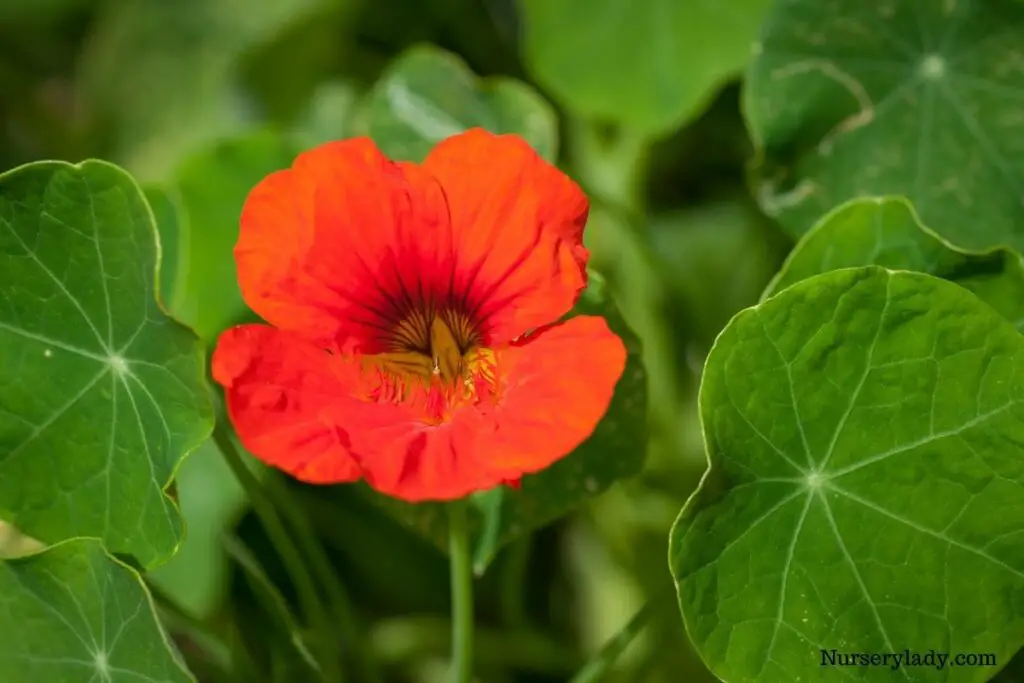
Jewel of Africa nasturtium is a cheerful climbing plant bearing flowers in various colors like orange, yellow, maroon, cream, etc. Its leaves and flowers are edible.
They will grow well on a trellis if appropriately maintained and look great in hanging baskets, garden edges, etc.
Light: To grow a healthy jewel of nasturtium, keep them in full sunlight. However, it will perform well in partial shade too. Ensure rotating them every few days for even lighting in all its parts.
Watering: Jewel of Africa nasturtium likes even moisture most of the time, and water it only when the soil is dry from the top. Overwatering can cause several issues in the plant.
Fertilizer: Jewel of Africa nasturtium does not need feeding. Though well-nourished, a balanced soil mix is sufficient for its growth and development. Avoid synthetic fertilizer, significantly, those growing it to eat.
General care: They prefer mild temperatures around 70°F. Jewel of Africa nasturtium likes average humidity. It can survive light frost but not very low temperatures.
Clematis
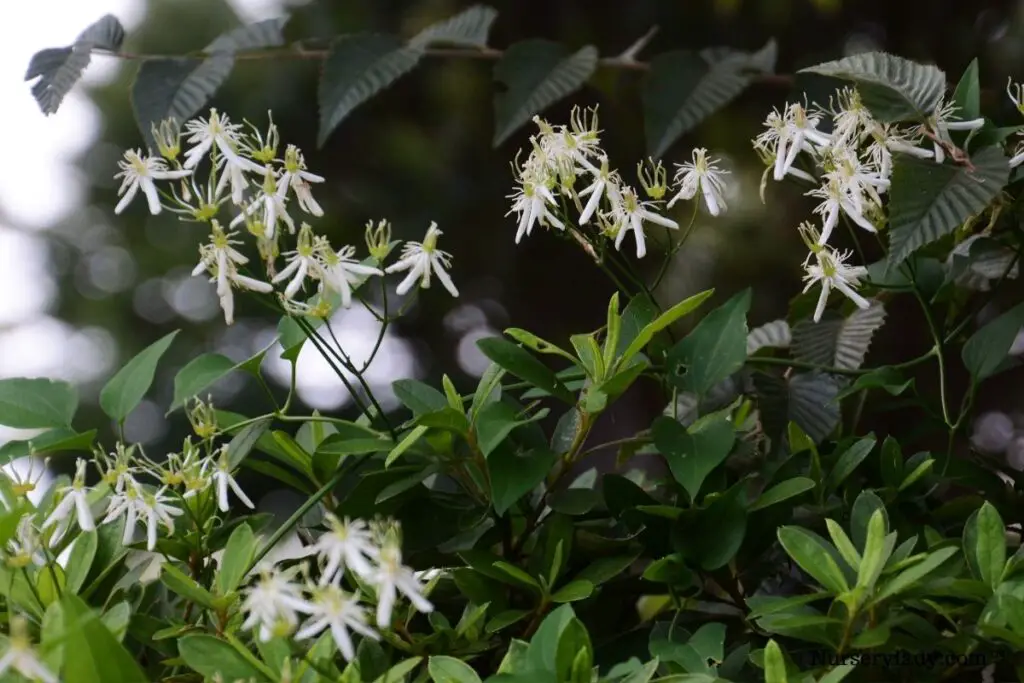
Clematis is a deciduous flowering vine that is easy to maintain. Wide varieties of clematis bloom at different times of the year.
You can mix and match them to keep your garden filled with climbing plants blooming throughout the year. A little care and maintenance will go a long way. Support it using a trellis, or grow them along a fence.
Light: Clematis will develop faster in sunny locations. Keep it near a window with at least 6 hours of sunlight daily. Proper lighting is essential for the plant to bloom.
Watering: Water clematis once a week, depending on the season. During high temperatures, water frequently and deeply allows excess moisture to drain out. Incorporate a layer of mulch to keep the soil and roots cool.
Fertilizer: Feed clematis during the growing season with a flowering fertilizer. Feed once or twice a month to promote flowering.
General care: Clematis needs good airflow to stay healthy or may be affected by pests and diseases. Prune it annually to keep them attractive and in shape. If you do research, you will find a variety of clematis for your cultural conditions.
Mandevilla
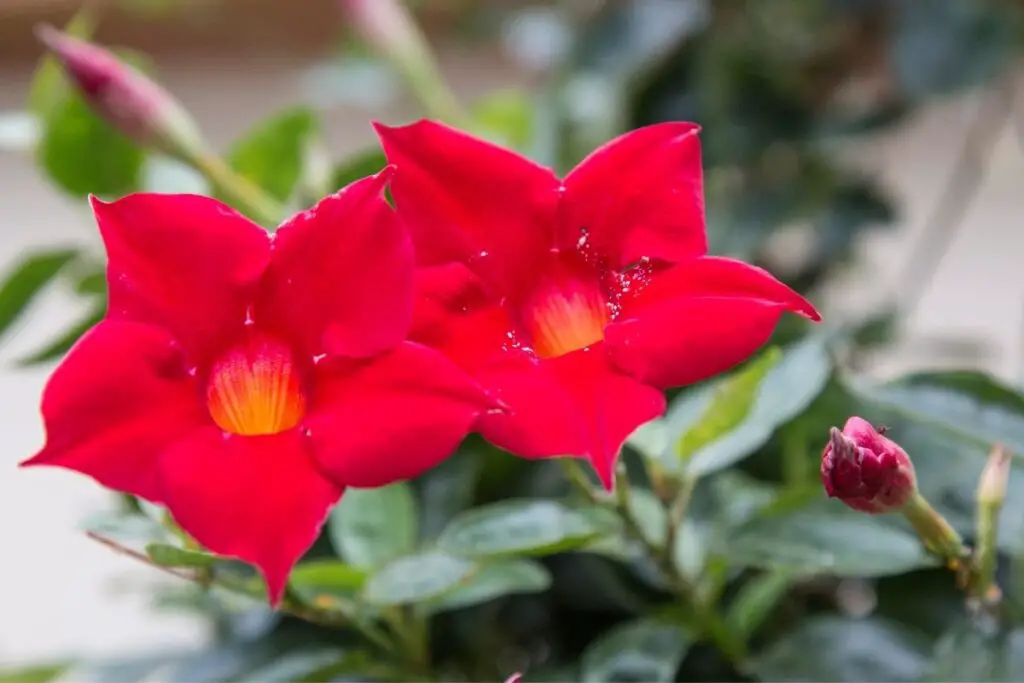
Mandevilla is a flowering vine bearing flowers in shades of pink, red, white, etc. It blooms in summer and all year long in warm climates.
It needs support to grow upward, such as a trellis or an arbor. It is fast-growing and grows well in hanging pots.
Light: Keep Mandevilla indirect sunlight for at least 6 hours on most days. Some shade is suitable for the plant during a hot summer afternoon.
Watering: Water Mandevilla to maintain even moisture in the soil. Water slowly and deeply to allow the soil to soak up the moisture and excess water to drain out. It can continue flowering in a short period of drought.
Fertilizer: Fertilize Mandevilla with a balanced organic fertilizer. You can either use slow-release fertilization or liquid fertilizer, as per your choice. Mixing compost is also a good way to add nutrition to the soil.
General care: Mandevilla loves humidity, and Misting them keeps them happy. Please keep them in warm temperatures, around 60°F. If the plant is outside, ensure the temperature is not below 50°F.
Bougainvillea
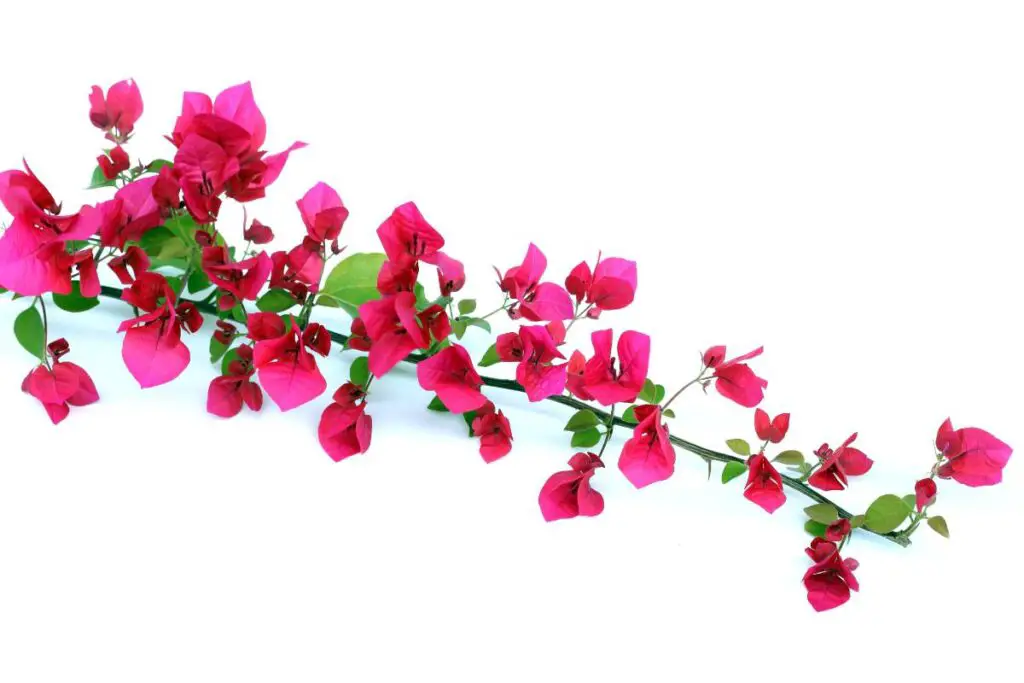
Bougainvillea is a dense flowering plant covered with brightly colored flowers all year round. It will catch everyone’s eye, primarily when grown in full sun. They are low maintenance and prosper in warm climates. Use trellis or fences to showcase their striking colorful flowers.
Light: Bougainvillea is a sun lover and grows best in total sun exposure. It is best to move them outdoors during summer for better lighting. During cooler months, it is essential to use alternative methods to provide sufficient light to the plant. Use grow lights and artificial light sources during cold weather.
Watering: Bougainvillea prefers evenly moist soil and will flourish in such conditions. Allow the top few inches of the soil to dry out between watering.
Fertilizer: Feed bougainvillea with a fertilizer formulated for the plant monthly by diluting it to half the recommended strength. Fertilizing is essential to produce flowers throughout the bloom season.
General care: Bougainvillea prefers high temperatures and can tolerate as low as 40°F. It likes humid conditions, and using a humidifier is helpful in dry temperatures.
Looking for gardening supplies? We have tested 100's of products before recommending them to you guys. Check out our best pick below:
| Image | Gardening Supplies | Best Price? |
|---|---|---|
 Top
Top Top
Top | Raised Garden Bed Kit | Check On Amazon |
 | XLUX Soil Moisture Meter, Plant Water Monitor, Soil Hygrometer Sensor for Gardening, Farming, Indoor and Outdoor Plants, No Batteries Required | No Results |
 Top
Top Top
Top | 82 Pcs Garden Tools Set and Extra Succulent Tools Set | Check On Amazon |
 | Joeys Garden Expandable Garden Hose with 8 Function Hose Nozzle, Lightweight Anti-Kink Flexible Garden Hoses, Extra Strength Fabric with Double Latex Core, (50 FT, Black) | No Results |
 Top
Top Top
Top | Dual Chamber Compost Tumbler | Check On Amazon |
 Top
Top Top
Top | Sunnyglade Plant Stakes | Check On Amazon |
 Top
Top Top
Top | Organic Cold Pressed Neem Seed Oil | Check On Amazon |
 Top
Top Top
Top | Mighty Mint Gallon :-Insect and Pest Control Peppermint Oil | Check On Amazon |
 Top
Top Top
Top | Scotts DiseaseEx Lawn Fungicide | Check On Amazon |
 Top
Top Top
Top | Jacks Classic 20-20-20 All Purpose Fertilizer | Check On Amazon |
 Top
Top Top
Top | 30,000 Seeds Pollinator Attracting Wildflower Mixture | Check On Amazon |
 Top
Top Top
Top | Survival Vegetable Seeds Garden Kit-Over 16,000 Seeds | Check On Amazon |
Black-eyed Susan
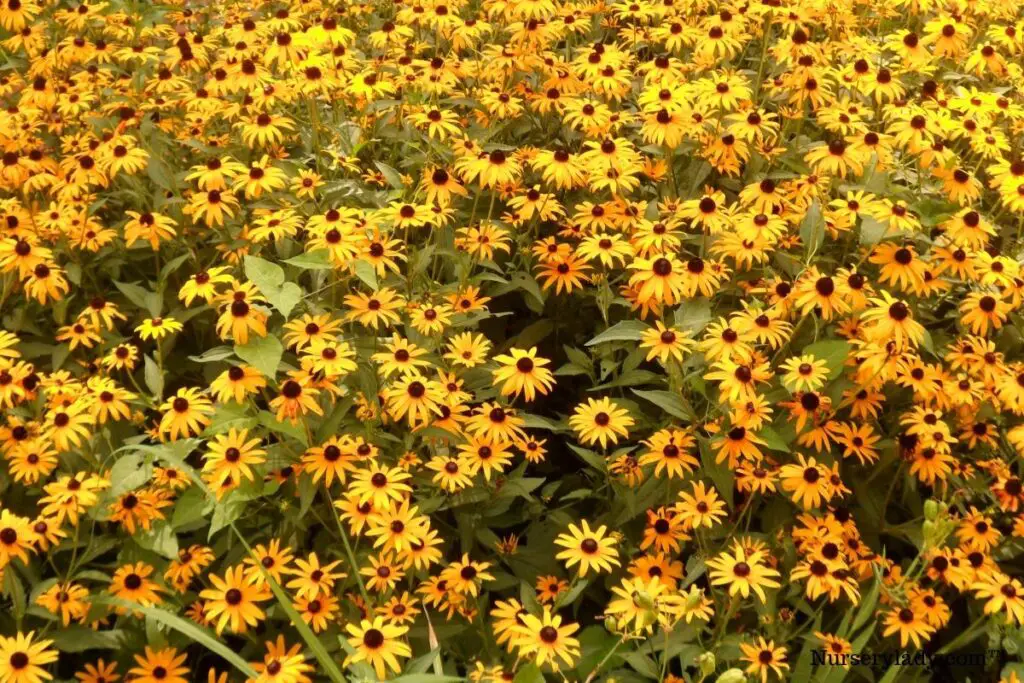
Black-eyed Susan is a lovely flowering vine that can be grown in a vertical garden or using a trellis. Its flowers are solid black at the center, surrounded by five petals that add a little drama to your space. It is fast-growing, invasively in warm climates, and can grow up to 6 – 8 feet.
Light: Keep your black-eyed Susan in full sun, i.e., at least 6 hours of direct sunlight on most days. It might need some shade if the climate is too hot and dry.
Watering: Water black-eyed Susan at regular intervals during hot and dry weather. Keep its soil evenly moist but not drowning. Checking the soil from the top before watering is best to avoid overwatering. You can use a mulch to moisten the soil if you are a forgetful owner.
Fertilizer: To grow black-eyed Susan rapidly and repeatedly bloom during the growing months, feed it with balanced fertilizer monthly. It is essential for plant growth and repeated blooming.
General care: Black-eyed Susan prefers temperature levels above 60°F, and it needs humidity only when the weather is dry. Use a soil mix with pH levels of 6.6 to 7.7 for your black-eyed Susan.
Morning glory
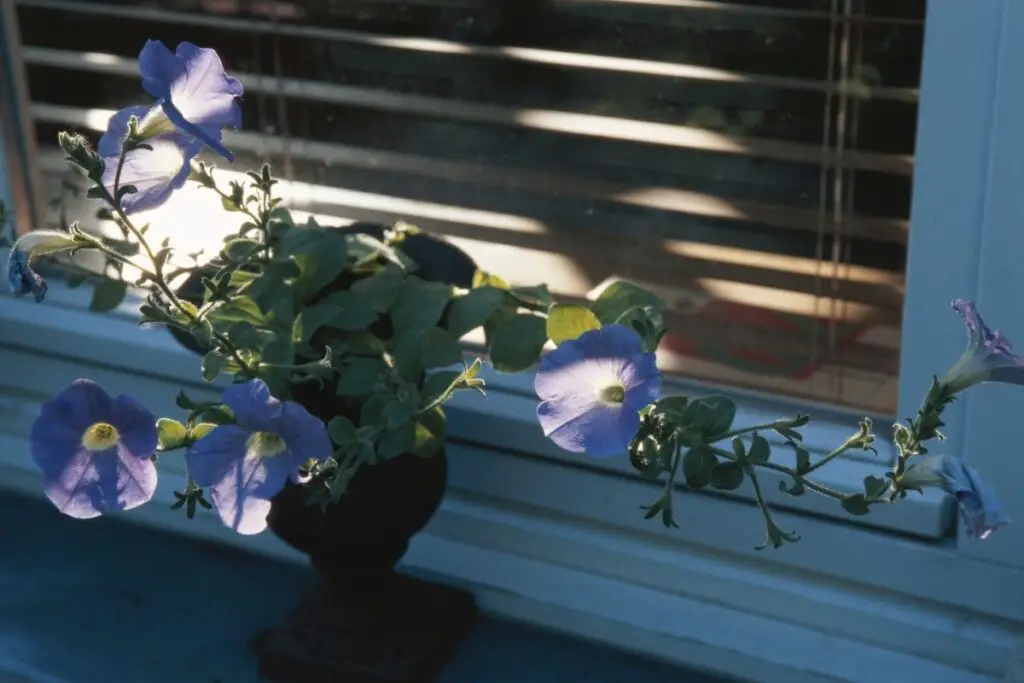
Morning glory has trumpet-shaped fragrant flowers in bright colors. It is perfect for decorating a space with its vines.
Use a trellis to grow them upward or as a backdrop for your other plants. It is toxic to people and loved amongst hummingbirds.
Light: Morning glory will open flowers only when it is in total sun exposure, and please keep it in full sun for at least 6 hours every day. You will not see flowers the next morning if they are in the shade or less light during the afternoon.
Watering: Morning glory needs regular watering to stay evenly moist. Proper watering is essential, especially during its growing period. Established morning glory needs watering less frequently, and mulching helps keep the soil and roots moist.
Fertilizer: Fertilize morning glory with low-nitrogen food once every month during its growing period. It helps in plant growth and abundant blooming.
General care: Morning glory can grow in both cold and warm weather. They are hardy enough to withstand frost and can expand in all humidity levels. They prefer well-draining soil and soil pH of 6 to 6.8.
Passionflower
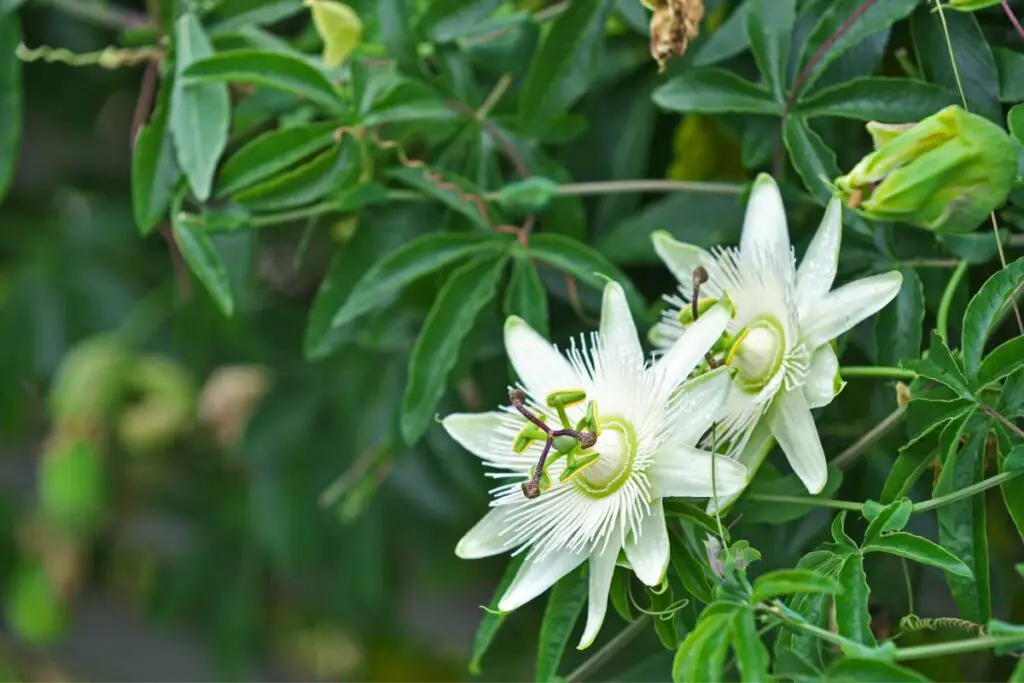
Passionflower is a hardy plant that can grow almost everywhere. It spreads vigorously, especially in warmer months. Its striking flowering vines look even more beautiful when trained on a trellis.
Light:
- Keep passion flowers in full sun to partial shade.
- Move it under a shade or near a tree during a scorching climate.
- During winter, use artificial light sources for passion flowers.
Watering: Water the passionflower deeply to allow excess water to drain out. Water when the soil is dry from the top and keep the soil evenly moist between waterings.
Fertilizer: Feed passion flowers with a balanced fertilizer once a month during the growing season. They are heavy feeders and will benefit from regular application.
General care: Passion Flowers prefer warm temperatures and can tolerate mild cold. Please keep them in an area away from winds and drafts. They do well in moderate to high humidity.
Chocolate vine
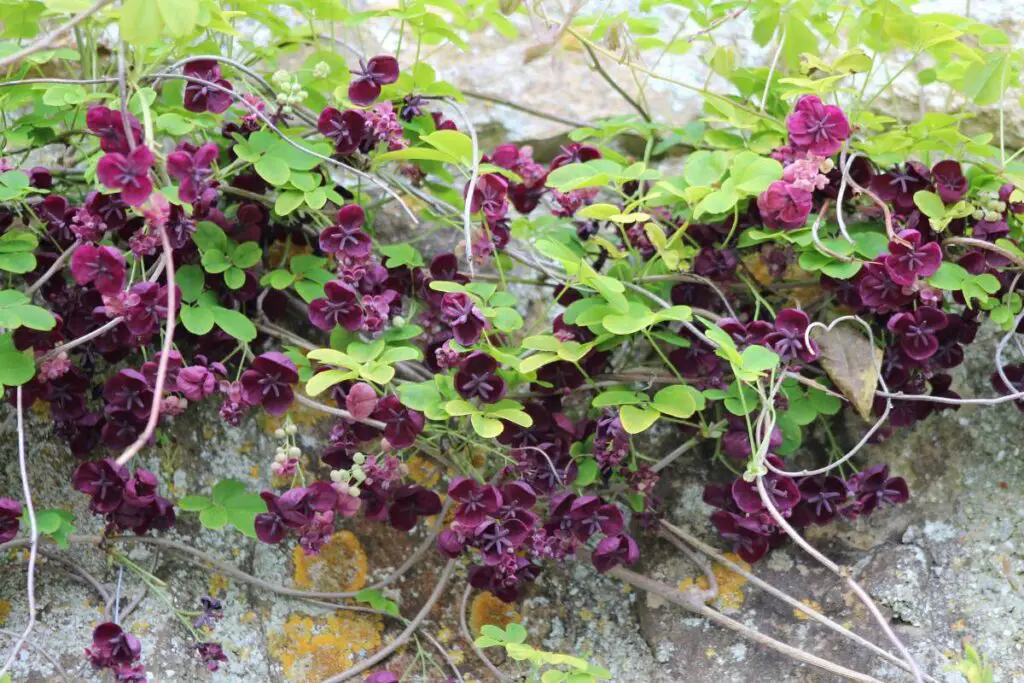
The chocolate vine bears delicate flowers with a chocolate-like fragrance. It has dark green glossy leaves that look beautiful as a vine.
To fully use its vines, use a support such as a trellis. It grows invasively and adds up to 40 feet every growing period.
Light: Chocolate vine can grow in full sun in shady locations. Though for best fruits and blooms, keep them in full sun. Expose them to direct sun for at least 6 hours on most days.
Watering: Water the chocolate vine when the soil is dry to the touch from the top. It is drought tolerant, but extended periods of drought may lead to issues. Ensure proper drainage to avoid overwatering.
Fertilizer: Feed the chocolate vine with a balanced fertilizer once in two months. You can also add mulch or manure to provide nutrients to the plant. Avoid too much feeding as it is a light feeder.
General care: Maintain moderate temperatures around the chocolate vine, i.e., between 55°F to 85°F. High humidity around the chocolate vine ensures good airflow.
Hardy kiwi vine
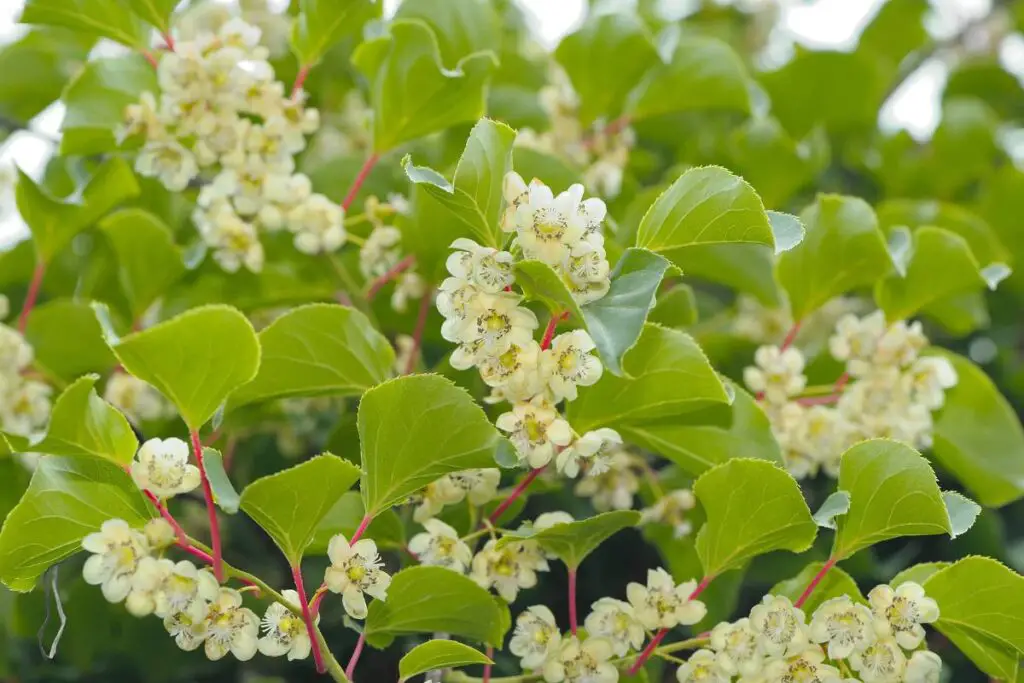
The hardy kiwi vine is a hardy plant with beautiful flowers in white and green. For a better look, train its vine using a support like a trellis, arbor, fence, etc.
You can manipulate it in whichever form you like. It is a fast-growing plant and needs proper care to flourish.
Light: Hardy kiwis can grow in almost all light conditions but flourish in full sun. Direct sun is essential for flowering and the superior color of its leaves.
Watering: Water hardy kiwis consistently while they are young. Once established, keep the plant moist but not soggy. Water deeply during dry spells and check the soil moisture before watering.
Fertilizer: Hardy kiwi vine is a light feeder. Applying 3 inches of compost to the base once in the spring should suffice. Avoid overfeeding hardy kiwi as it can cause root burn, etc.
General care: Hardy kiwi vine prefers warm temperatures and can survive cool temperatures but suffer from frost. During dormancy, it can survive temperatures as low as 25°F.
Snail vine
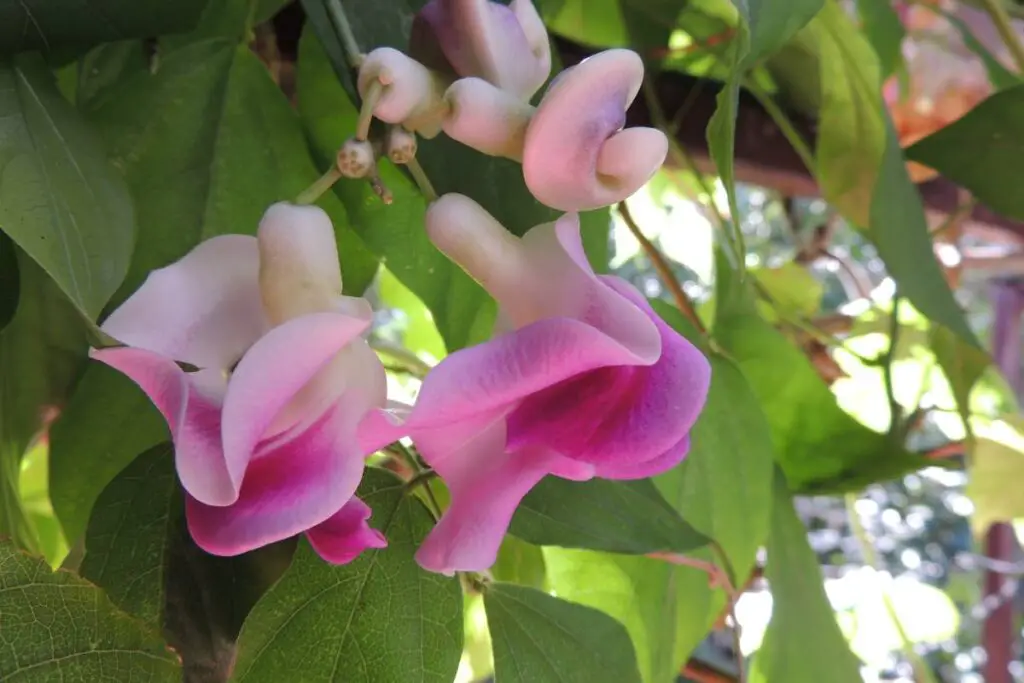
The Snail vine is an attractive tropical vine that stands out among other flowering plants. They produce fragrant flowers in a variety of colors.
Grow its vines on the trellis, wall covers, or fence and control its vigorous growth. It is a fast-growing vine that can extend up to 20 feet.
Light: Keep snail vine in partial sun to avoid sunburn. In cool weather, you can keep in direct sunshine, but in hot weather, avoid direct harsh sunlight. Plant drooping and drying out are signs of the plant getting too much light.
Watering: Water snails vine thoroughly at regular intervals and ensure proper drainage. Keep checking the soil moisture to avoid over and under-watering issues. Misting the plant is preferred during dry climates.
Fertilizer: Snail vine is a light feeder. Adding compost in spring helps in nourishing the soil. You can use a slow-release fertilizer once every two months while the plant is actively growing.
General care: Snail vine prefers moderate to high temperatures. Keep the plant in high humidity and good airflow. Prune in regular intervals to remove dead foliage and keep it in shape.
Moonflower
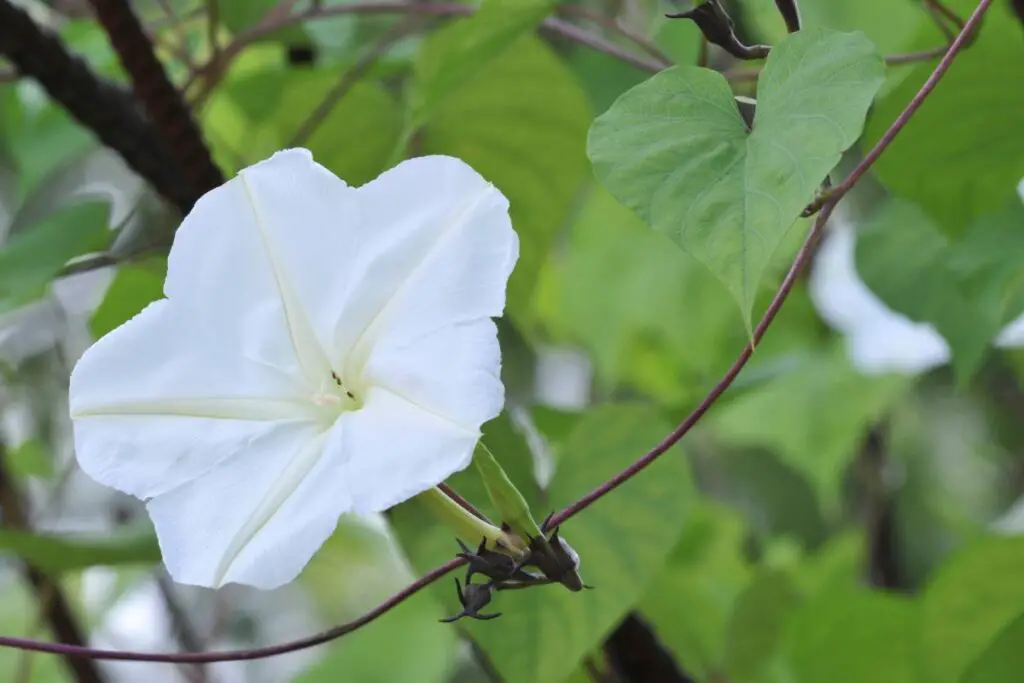
Moonflower is a stunning flowering vine and adds beauty to the night garden. It has sizable robust foliage and trumpet-shaped blooms.
Its vines climbing nature requires support to grow and spread. Use a trellis, fence, or other support structure to grow its vines. This fast-growing flowering vine can reach up to 20 feet in height.
Light: Moonflower prefers direct sun for as many hours as possible. It can survive in partially shaded locations but will have fewer or no flowers.
Watering: Water the moonflower when the soil is dry on the top. Young moonflowers need frequent watering as compared to established plants. It can survive short periods of drought, but long dry spells can kill the plant.
Fertilizer: The moonflower is a light feeder, but feeding during its bloom is appreciated. Feed with diluted high-phosphorus fertilizer once a month when the plant is blooming.
General care: Moonflower thrives in warm temperatures and humid conditions. A temperature between 60°F and 70°F is best for the plant.
Trumpet vine
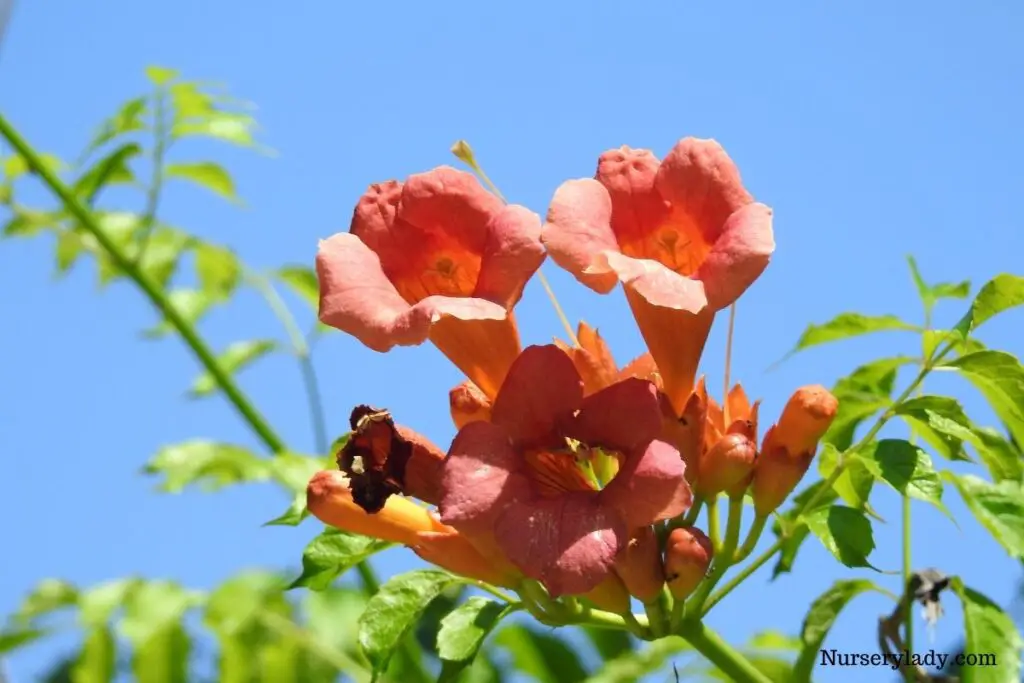
The trumpet vine is fast-growing with dark green foliage and trumpet-shaped flowers. It grows and spreads aggressively, which needs to be monitored.
Use support structures like a trellis, fence, etc., to raise its upward and shape vines. In favorable locations, it can live for many decades.
Light: Keep trumpet vine in partial shade to full sun. In full sun, the plant will have better and more abundant flowering.
Watering: Water the trumpet vine when the soil is dry to avoid sogginess. The plant can tolerate drought for a good period. Water the plant once a week in warm temperatures.
Fertilizer: Trumpet vines are easiest to grow and thrive in lean soil. It doesn’t need any supplemental feeding as it can push its growth speed, which can be uncontrollable.
General care: Trumpet vine prefers hot temperatures and high humidity. Keep pruning its vines to control its vigorous growth. It is best to prune in early spring before the development begins.
Climbing hydrangea
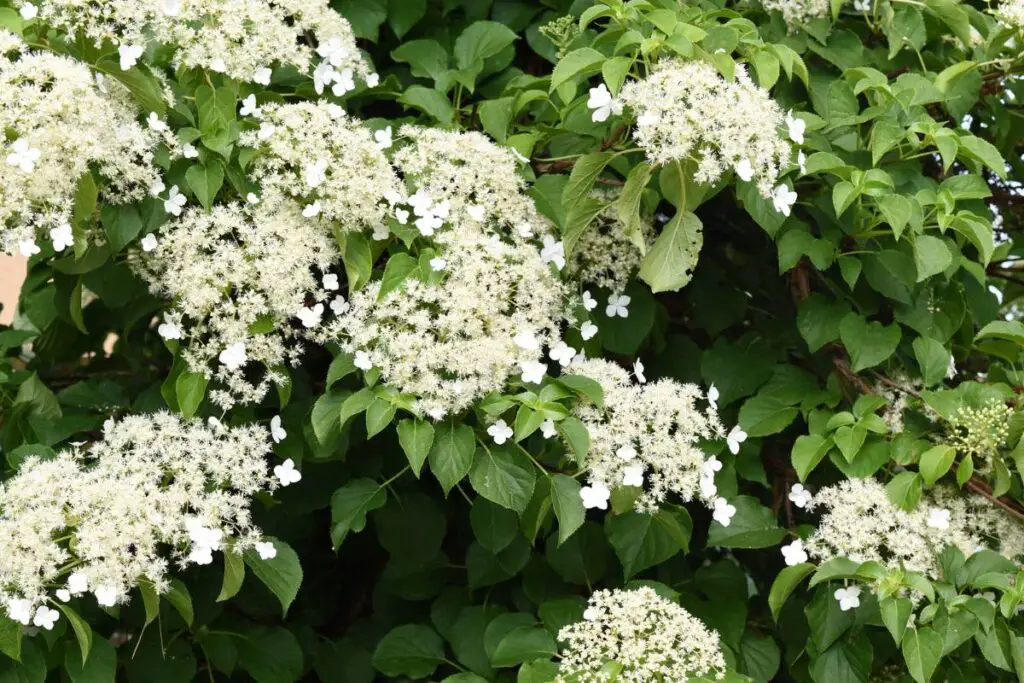
Climbing hydrangea is an eye-catching vine that has fragrant lacy flowers. It grows slowly and takes years to produce flowers finally. You can use trellis, pergolas, and fences to train its heavy vines and showcase its beauty.
Light: Grow climbing hydrangea in direct sunlight for best performance. However, it can also grow in partial shade but has lesser blooms. During hot climates, it prefers some shade or at least consistent watering.
Watering: Water climbing hydrangea regularly ensures the soil is evenly moist. Avoid too much watering and ensure proper drainage. Water it weekly or more when the weather is dry and hot
Fertilizer: Feed climbing hydrangea once the leaves start to bud with a balanced fertilizer. Adding compost and mulch to the plant in late summer will boost their growth.
General care: Maintain moderate temperature around climbing hydrangea. Move the plant to favorable locations when the weather is hot and humid. They need six weeks of temperature below 65°F to set buds.
Star Jasmine
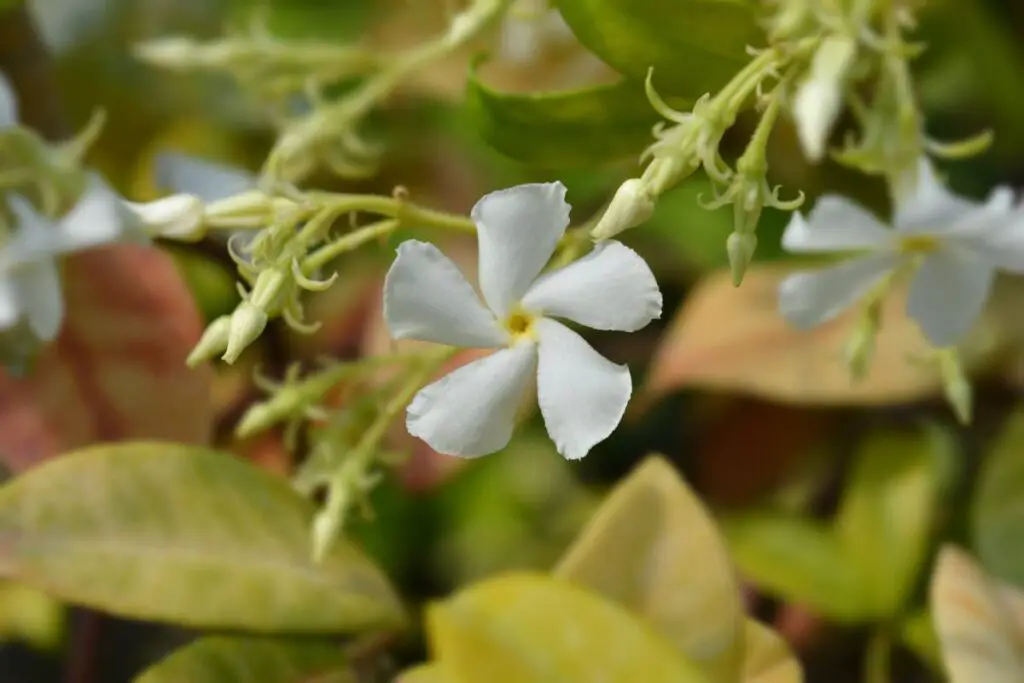
Star Jasmine is an attractive, low-maintenance plant with fragrant flowers. Its vines can grow upward with the support of a trellis or can spread as ground cover, and it overgrows and can extend up to 6 feet in height.
Light: Star Jasmine can grow in all light conditions but will flower best in full sun. On most days, it needs at least 8 hours of sunlight for abundant flowering.
Watering: Star jasmine appreciates regular watering, especially in hot and dry weather. It is best to check the soil at the top by digging a finger up to 2 inches to determine if the soil is dry. If it feels moist, then wait for it to dry out.
Fertilizer: Star jasmine will have better blooming and growth with proper feeding. Use a balanced slow-release food in early spring and summer to feed star jasmine.
General care: Star jasmine prefers temperatures ranging between 60°F to 75°F. It is cold and hardy and can bear temperatures as low as 10°F for a short period. It will flourish in moderately moist conditions.
Sweet pea
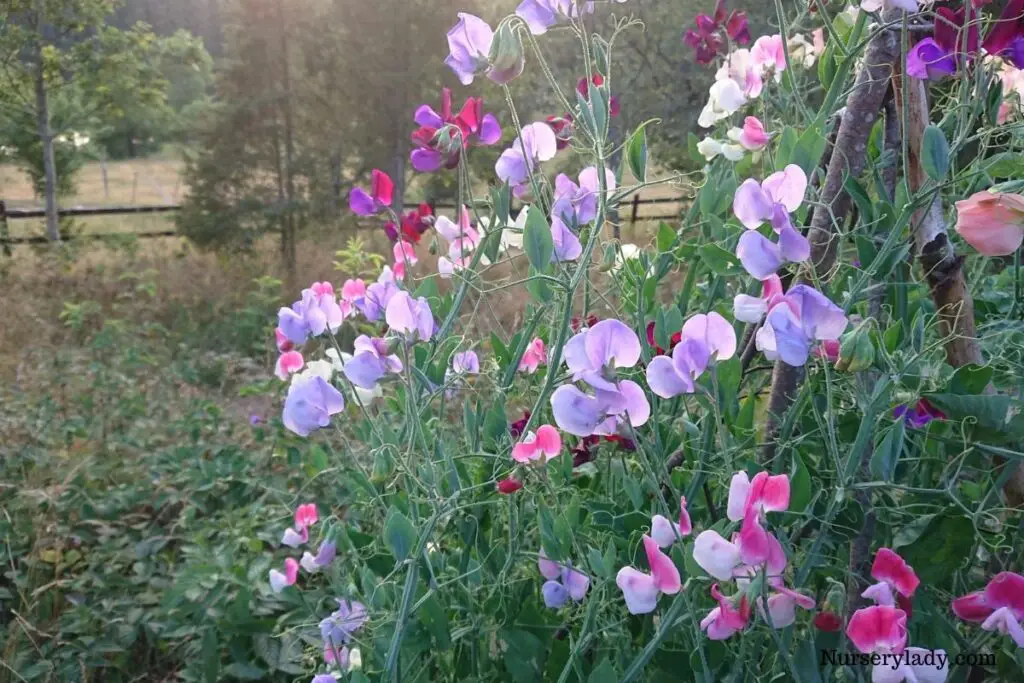
Sweet pea is an attractive plant with colorful, fragrant blooms. It blooms in spring and summer. It looks beautiful when trained on a trellis, fences, etc.
It is a fast-growing and low-maintenance plant, making it easier for beginners to grow. Its vines can extend up to 8 feet tall.
Light: Sweet peas grow and bloom best in full sun. However, they would appreciate some shade during hot temperatures, and full shade can inhibit their flowering and growth.
Watering:
- Water sweet peas thoroughly once a week and allow the excess water to drain.
- Check soil moisture by digging a finger in the soil from the top.
- If the soil feels dry, water it deeply.
Fertilizer: Sweet peas need feeding once every month throughout their growing season. Fertilize it with high-potassium fertilizer by diluting it to half the recommended strength. Adding compost will also help in nourishing the soil.
General care: Sweet peas like warm temperatures and can tolerate chilly winters. Prune it and cut its growing tips to increase branching. Pruning in regular intervals will promote flowering.
